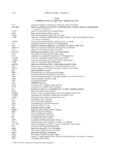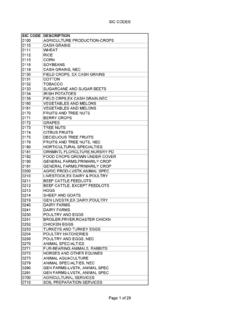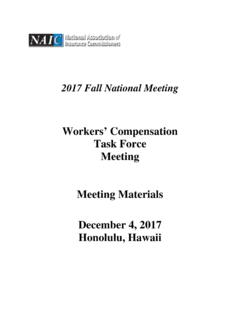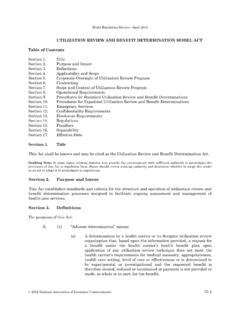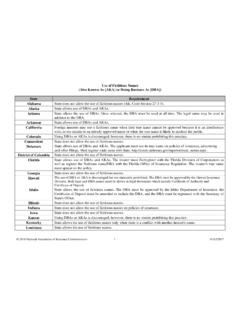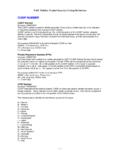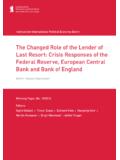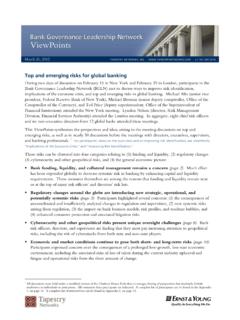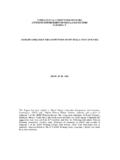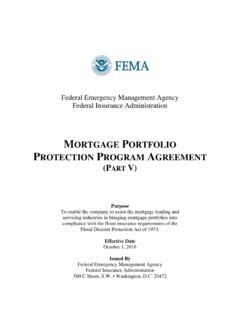Transcription of NAIC Natural Catastrophe Risk: Creating a …
1 6/15/2009 2009 National Association of Insurance Commissioners 1 Natural Catastrophe Risk: Creating a Comprehensive National Plan This paper contains various perspectives on preparing the United States of America and the various states for Natural catastrophes. The various perspectives are presented to demonstrate the diversity of views on this important topic. Natural Catastrophe Insurance Plan - Version 15a 6/15/2009 2009 National Association of Insurance Commissioners 1 Natural Catastrophe Insurance Plan - Version 15a 6/15/2009 2009 National Association of Insurance Commissioners 2 Draft: June 13, 2009 Natural Catastrophe Risk: Creating a Comprehensive National Plan NAIC Property and Casualty Insurance (C) Committee Working Draft, December 2008 Introduction Natural disasters take a heavy financial and emotional toll on Americans every year.
2 Following Hurricane Katrina, the Government Accountability Office (GAO) issued a report that concluded the United States is not well prepared to handle large Natural disasters; this includes the initial emergency response as well as the financial aftermath. Americans need to be better prepared for Natural disasters both logistically and financially; insurance has an important role to play in this equation. The National Association of Insurance Commissioners (NAIC) has actively examined approaches to insuring against Natural disasters for the last four decades.
3 In fact, Volume 1 of the 1973 NAIC Proceedings cites a report from the Availability of Essential Insurance (D2) Subcommittee that recommends a five-step program to address this problem. Interestingly, step five is, The Federal Government, in cooperation with the insurance industry and the NAIC, study and develop a mechanism that would provide additional capacity for Catastrophe insurance and would allow for the accumulation of funds from which Catastrophe losses could be paid without having those funds depleted by Federal income tax in loss-free years.
4 " The Property and Casualty (C) Committee has developed a possible model system for implementing this concept of tax deferred Catastrophe reserves, and has advocated legislative changes to the Federal Tax Law since 2000. More recently, the (C) Committee re-constituted the Catastrophe Reserve Subgroup to revisit the model system and to recommend possible changes. The 1973 NAIC report also precipitated continued discussions of developing an additional security mechanism to insure against national catastrophes. In February 2005, the Catastrophe Insurance Working Group (CIWG) of the NAIC s Property Casualty (C) Committee held an interim meeting in Orlando, Florida to consider the US insurance industry s Catastrophe readiness.
5 More importantly, the committee also began to develop a comprehensive national plan to manage catastrophic risk, and utilized the guiding principles first established by the NAIC in 1999 (see Appendix I). The CIWG report summarized the work to date, and highlighted one important fact: a truly comprehensive solution will not only require a commitment of resources from the regulatory community and the insurance industry, but also from the federal, state and local governments. The insurance industry cannot be expected to provide comprehensive Catastrophe coverage without adequate financial backstops for the most extreme events.
6 This report outlines steps that regulators believe must be taken to accomplish the dual purpose of providing a comprehensive plan that protects the public, while simultaneously providing assurances to the insurance industry should the big one occur. Another issue is that even now, some of the nation s most exposed residential customers are experiencing difficulties with the availability and affordability of insurance products -- future catastrophic losses will only exacerbate this problem. As would be expected, regulators and the insurance industry do not agree on how best to resolve these issues; these divergent viewpoints are noted throughout the report.
7 Background There have been several recent Natural disasters that have captured the nation s attention. The following examples highlight the estimated insured losses using 2007 dollars. In 1989, Hurricane Hugo caused $ billion in insured losses to South Carolina. In 1992, Hurricane Andrew devastated Florida resulting in $ billion in insured losses. In 1994 the Northridge Earthquake in California cost insurers a total of $ billion. In 2004, four major hurricanes reached landfall in the Gulf Coast States which included Hurricane Charlie ($ billion) followed by Ivan ($ billion), Frances ($ billion) and Jeanne ($ billion).
8 The most costly hurricane ever was Katrina in 2005 with insured loss estimates in excess of $42 billion. Two other hurricanes in 2005 Wilma and Rita caused $ billion and nearly $5 billion in damage respectively. It is not simply the frequency of large storms that created financial problems for the insurance industry --- all seven of these storms are now included in the list of top ten costliest storms in United States history. With a few exceptions, all of the insured losses related to wind-damage have been handled by the insurance industry. The uninsured losses associated with these events have been paid by the states and the federal government using taxpayer funds.
9 Natural Catastrophe Insurance Plan - Version 15a 6/15/2009 2009 National Association of Insurance Commissioners 3 Despite relatively quiet storm seasons in 2006 and 2007, these catastrophic losses have public policymakers concerned about the industry s ability to continue to handle these catastrophic losses, as well as to continue to have the capacity to handle the next major Natural disaster. The Potential for a Mega-Disaster While Hurricane Katrina was devastating, Catastrophe modelers have identified a number of possible Natural disasters that would dwarf the damages caused by this event.
10 These are not fantastic scenarios, but instead, have already occurred in our nation s history just not at current exposures, and structure values. The 1906 San Francisco earthquake would create damage of $400 billion with over $200 billion in uninsured property losses if it had occurred today; a repeat of the 1900 Galveston hurricane would cause $36 billion in possible damages; a repeat of the 1938 Category 3 hurricane that reached landfall in the Northeast would cause damage exceeding $300 billion; a repeat of the series of earthquakes that struck the New Madrid Fault in 1811 and 1812 would cause potential economic damage of up to $275 billion with insured losses reaching $100 billion.

